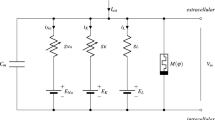Abstract
The possible influence of time-varying magnetic fields on action potential in the lobster giant axon was studied. The axon membrane was excited by galvanic stimulation and the action potential was recorded intracellularly with microelectrodes. During the propagation of the action potential along the axon, alternating or pulsed magnetic fields were applied across the middle part of the axon to study whether or not magnetic fields have any effect on parameters such as conduction velocity and refractory period of the nerve fibre and amplitude, duration and shape of the action potentials. No effect on these parameters was observed under different flux densities and frequencies of the magnetic fields. When simulating the conductive properties of tissue surrounding the nerve with the aid of an external conducting loop with a load resistance, action potentials were generated which made it possible to study the threshold value of the induced eddy current for nerve excitation. Based on the results of the experiment, the influence of magnetic flux density, frequency, conductivity, induced EMF and induced eddy current density is discussed, and a method is proposed for estimating the threshold values of magnetic flux density for nerve excitation.
Similar content being viewed by others
References
Aceto, H. Jr., Tobias, C. A. andSilver, I. R. (1970) Some studies on the biological effects of magnetic fields.IEEE Trans.,MAG-6, 368–373.
Barnothy, M. F. (1964)Biological effects of magnetic fields. Plenum Press, New York.
Barnothy, M. F. (Ed.) (1969)Biological effects of magnetic fields, vol. 2, Plenum Press, New York.
Battocletti, J. H. (1976)Electromagnetism, man and the environment. Westview Press, Boulder, Colorado.
Becker, R. O. (1963) The biological effects of magnetic fields. A survey.Med. Electron. Biol. Eng.,1, 293–303.
Bickford, R. G. andFremming, B. D. (1965) Neuronal stimulation by pulsed magnetic fields in animals and man. Dig. 6th Int. Conf.Med. Electr. Biol. Eng., 112.
Budinger, T. F. (1979) Thresholds for physiological effects due to RF and magnetic fields used in NMR imaging.IEEE Trans.,NS-26, 2821–2825.
Busby, D. E. (1968) Space biomagnetics.Space Life Science,1, 23–63.
Dalton, J. C. (1958) Effects of external ions on membrane potentials of a lobster giant axon.J. Gen. Physiol.,41, 529–542.
D’Arsonval, M. A. (1896) Dispositifs pour la mesure des courants alternatifs de toutes frequences.C. R. Biol. (Paris), 450–451.
Frei, E. H. (1972) Biomagnetics.IEEE Trans.,MAG-8, 407–413.
Grisett, J. D. (1980) Biological effects of electric and magnetic fields associated with ELF communications systems.Proc. IEEE. 68, 98–104.
Irwin, D. D., Rush, S., Evering, R., Lepeschkin, E., Montgomery, D. B. andWeggel, R. J. (1970) Stimulation of cardiac muscle by a time-varying magnetic field.IEEE Trans.,MAG-6, 321–322.
Kolin, A., Brill, N. O. andBroberg, P. J. (1959) Stimulation of irritable tissues by means of an alternating magnetic field.Proc. Soc. Exp. Biol. Med.,102, 251–253.
Llaurado, J. G., Sances, A. andBattocletti J. H. (Eds.) (1974)Biological and clinical effects of low-frequency magnetic and electric fields. Charles C. Thomas, Springfield, Illinois.
Lövsund, P., Öberg, P. Å. andNilsson, S. E. G. (1979) Influence on vision of extremely low frequency electromagnetic fields.Acta Ophthal.,57, 812–821.
Lövsund, P., Öberg, P. Å. andNilsson, S. E. G. andReuter, T. (1980a) Magnetophosphenes: a quantitative analysis of thresholds.Med. & Biol. Eng. & Comput.,18, 326–334.
Lövsund, P., Öberg, P. Å. andNilsson, S. E. G. (1980b) Magneto- and electrophosphenes: a comparative study.18, 758–764.
Lövsund, P., Nilsson, S. E. G. andÖberg, P. Å. (1981) Influence on frog retina of alternating magnetic fields with special reference to ganglion cell activity.,19, 679–685.
Maass, J. A. andAsa, M. M. (1970) Contactless nerve stimulation and signal detection by inductive transducer.IEEE Trans.,MAG-6, 322–326.
Öberg, P. Å. (1973) Magnetic stimulation of nerve tissue.Med. & Biol. Eng.,11, 55–64.
Persinger, M. A. (Ed.) (1974)ELF and VLF electromagnetic field effects. Plenum Press, New York.
Presman, A. S. (1970)Electromagnetic fields and life. Plenum Press, New York.
Sheppard, A. R. andEisenbud, M. (1977)Biological effects of electrical and magnetic fields of extremely low frequency. New York University Press, New York.
Schwartz, J.-L. (1976) Influence of a constant magnetic field on nervous tissues: I. Nerve conduction velocity studies.IEEE Trans.,BME-25, (5).
Schwartz, J.-L. (1979). Influence of a constant magnetic field on nervous tissues: II. Volgate-clamp studies.Ibid.,BME-26 (4).
Tenforde, T. S. (Ed.) (1979)Magnetic field effects on biological systems. Plenum Press, New York.
Valentinuzzi, M. (1962) Theory of magnetophosphenes.Am. J. Med. Electron.,1, 112–121.
Valentinuzzi, M. (1965) Note on magnetic actions upon the nervous system.Bull. Math. Biophys,27, special issue, 203–214.
Author information
Authors and Affiliations
Additional information
Shoogo Ueno was a visiting research scientist in 1979–1981 under grants while on leave from Kyushu University, Department of Electronics, Fukuoka 812, Japan, which is his present address. per Lövsund is now at Chalmers University of Technology, Department of Traffic Safety, S-412 96 Göteborg, Sweden.
Rights and permissions
About this article
Cite this article
Ueno, S., Lövsund, P. & Öberg, P.Å. Effect of time-varying magnetic fields on the action potential in lobster giant axon. Med. Biol. Eng. Comput. 24, 521–526 (1986). https://doi.org/10.1007/BF02443969
Received:
Accepted:
Issue Date:
DOI: https://doi.org/10.1007/BF02443969




